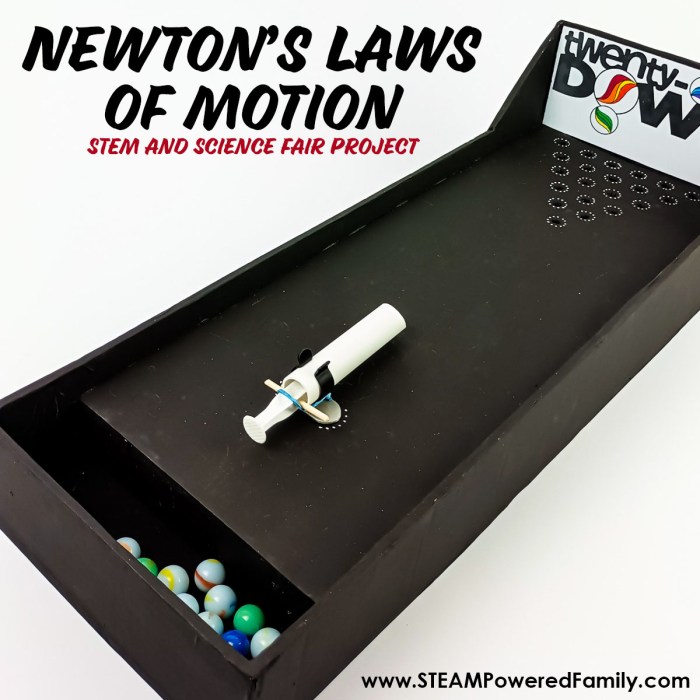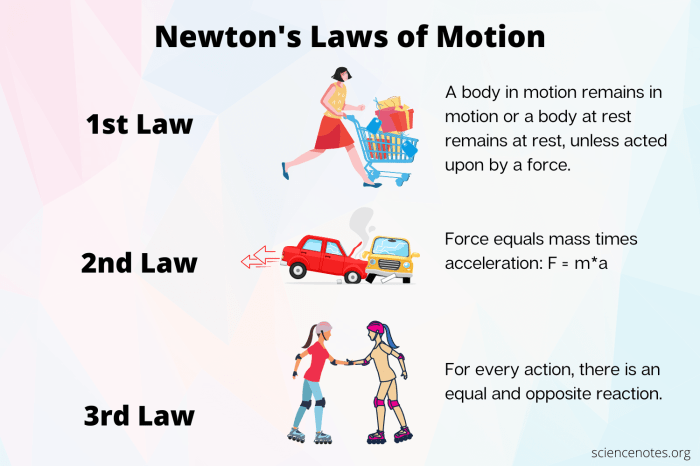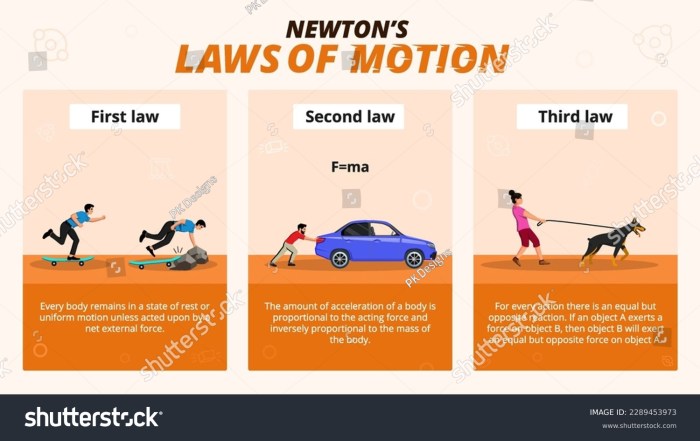
What are Newton’s laws of motion? These three fundamental laws, formulated by Sir Isaac Newton in the 17th century, form the bedrock of classical mechanics, describing the motion of objects in our everyday world. From understanding why objects stay at rest or continue moving, to explaining how forces cause acceleration, these laws have revolutionized our understanding of the physical universe.
Newton’s laws are not just theoretical concepts; they are deeply intertwined with our daily lives. They are the foundation for everything from designing bridges and buildings to understanding the flight of a bird or the movement of a car. By delving into these laws, we unlock a deeper appreciation for the intricate workings of the physical world around us.
Newton’s Second Law of Motion

Newton’s Second Law of Motion, often referred to as the law of acceleration, is a fundamental principle in physics that describes the relationship between force, mass, and acceleration. It states that the acceleration of an object is directly proportional to the net force acting on it and inversely proportional to its mass. This law is crucial for understanding how objects move and interact with their surroundings.
Force and Acceleration
Force is a push or pull that can change an object’s motion. It is a vector quantity, meaning it has both magnitude and direction. Acceleration is the rate of change of velocity over time. It is also a vector quantity, indicating both the magnitude and direction of the change in velocity.
The relationship between force and acceleration is described by Newton’s Second Law. According to this law, a net force applied to an object causes it to accelerate. The greater the force, the greater the acceleration. Conversely, the greater the mass of the object, the smaller the acceleration for a given force.
Quantifying the Relationship Between Force, Mass, and Acceleration
Newton’s Second Law can be mathematically expressed as:
F = ma
where:
* F represents the net force acting on the object (in Newtons)
* m represents the mass of the object (in kilograms)
* a represents the acceleration of the object (in meters per second squared)
This equation indicates that force is directly proportional to both mass and acceleration. This means that if you double the force acting on an object, you will double its acceleration. Similarly, if you double the mass of an object, you will halve its acceleration for the same force.
Examples of Force Affecting Acceleration and Vice Versa
* Pushing a Shopping Cart: When you push a shopping cart, you apply a force to it. The heavier the cart (greater mass), the less it accelerates for a given force.
* Throwing a Ball: When you throw a ball, you apply a force to it. The harder you throw (greater force), the faster the ball accelerates.
* Braking a Car: When you apply the brakes in a car, you apply a force to the wheels. This force causes the car to decelerate (slow down). The greater the force applied by the brakes, the faster the car decelerates.
Newton’s Third Law of Motion
Newton’s Third Law of Motion, also known as the law of action and reaction, is a fundamental principle in physics that describes the interactions between objects. It states that for every action, there is an equal and opposite reaction. This means that when one object exerts a force on another object, the second object exerts an equal and opposite force back on the first object.
Action and Reaction Forces
This law is based on the idea that forces always occur in pairs. When two objects interact, they exert forces on each other. These forces are always equal in magnitude and opposite in direction. The force exerted by the first object on the second object is called the “action” force, and the force exerted by the second object on the first object is called the “reaction” force.
Examples of Action-Reaction Pairs, What are newton’s law
Here are some examples of action-reaction force pairs:
- When you push against a wall, the wall pushes back on you with an equal and opposite force.
- When you jump up, your feet exert a force on the ground, and the ground exerts an equal and opposite force on your feet, propelling you upwards.
- When a rocket launches, the rocket engines expel hot gases downwards, and the gases exert an equal and opposite force on the rocket, propelling it upwards.
Importance of Newton’s Third Law
Understanding Newton’s Third Law is crucial in various scenarios:
- Rocket Propulsion: The propulsion of rockets is a prime example of Newton’s Third Law in action. The rocket engines expel hot gases downwards, and the gases exert an equal and opposite force on the rocket, propelling it upwards.
- Walking: When you walk, your feet push backward on the ground, and the ground pushes forward on your feet. This forward force is what propels you forward.
- Swimming: When you swim, you push water backward with your arms and legs, and the water pushes you forward with an equal and opposite force.
Limitations of Newton’s Laws: What Are Newton’s Law

Newton’s laws of motion, while incredibly successful in describing the motion of everyday objects, have limitations when dealing with extreme scenarios involving very high speeds or strong gravitational fields. These limitations led to the development of Einstein’s theory of relativity, which provides a more accurate description of motion in these extreme conditions.
Relativity and the Modification of Newton’s Laws
Einstein’s theory of relativity fundamentally changes our understanding of space, time, and gravity. It proposes that:
- The speed of light is constant: Regardless of the observer’s motion, the speed of light in a vacuum is always the same, approximately 299,792,458 meters per second. This constant speed has profound implications for how we perceive time and space.
- Time is relative: Time is not absolute but is relative to the observer’s motion. For example, two observers moving at different speeds will experience time differently. This phenomenon is known as time dilation.
- Space and time are interconnected: Space and time are not separate entities but are interwoven into a single continuum known as spacetime. Gravity is a curvature of spacetime caused by mass and energy.
These concepts have significant implications for Newton’s laws of motion:
- Newton’s laws break down at high speeds: At speeds approaching the speed of light, the predictions of Newton’s laws become increasingly inaccurate. For example, Newton’s laws predict that an object’s mass remains constant, but relativity shows that mass increases with velocity.
- Newton’s laws do not account for the curvature of spacetime: In strong gravitational fields, the curvature of spacetime becomes significant, and Newton’s laws fail to accurately describe the motion of objects. For instance, Newton’s law of gravity predicts that objects in orbit will follow elliptical paths, but general relativity predicts that the paths are slightly curved due to the curvature of spacetime.
Advancements in Physics
Newton’s laws laid the foundation for classical mechanics, but they have been extended and refined by subsequent developments in physics:
- Quantum Mechanics: Quantum mechanics deals with the behavior of matter and energy at the atomic and subatomic levels. It introduces concepts such as wave-particle duality, quantization of energy, and uncertainty principles, which are not explained by classical mechanics.
- Special Relativity: Special relativity, formulated by Einstein in 1905, deals with the relationship between space and time and the consequences of the constant speed of light. It modifies Newton’s laws of motion for objects moving at high speeds.
- General Relativity: General relativity, also formulated by Einstein in 1915, extends special relativity to include gravity. It describes gravity as a curvature of spacetime caused by mass and energy.
Summary

Newton’s laws of motion, despite their limitations in extreme scenarios, remain a cornerstone of physics. They provide a powerful framework for understanding the behavior of objects in motion, enabling us to predict and control their movements. As we continue to explore the universe and push the boundaries of science, Newton’s laws will continue to inspire and guide our understanding of the fundamental principles governing the motion of everything around us.
Expert Answers
What are the three laws of motion?
The three laws of motion are:
- Law of Inertia: An object at rest stays at rest, and an object in motion stays in motion at a constant velocity, unless acted upon by a net external force.
- Law of Acceleration: The acceleration of an object is directly proportional to the net force acting on it and inversely proportional to its mass.
- Law of Action-Reaction: For every action, there is an equal and opposite reaction.
How do Newton’s laws apply to everyday life?
Newton’s laws are applied in many aspects of everyday life, such as:
- Driving: When you press the gas pedal, you apply a force that accelerates the car. When you brake, you apply a force that decelerates the car.
- Playing sports: Hitting a baseball, kicking a soccer ball, or throwing a basketball all involve applying forces to objects in motion.
- Construction: Engineers use Newton’s laws to design structures that can withstand the forces of gravity and wind.
What are some limitations of Newton’s laws?
Newton’s laws are not perfect. They break down at very high speeds or in very strong gravitational fields. For example, Einstein’s theory of relativity provides a more accurate description of motion at high speeds.




